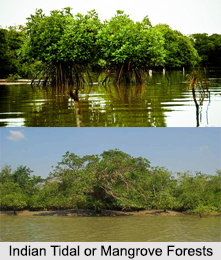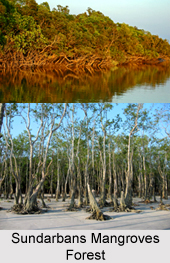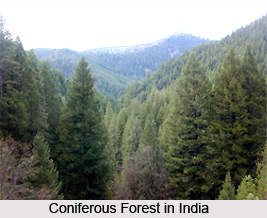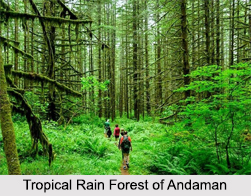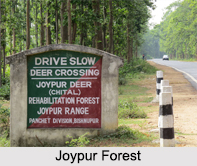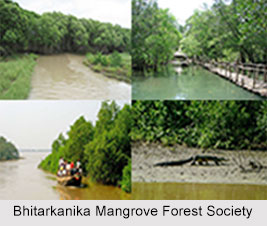 Bhitarkanika Mangrove Forests are a mangrove wetland in Odisha comprising the districts of this region.
Bhitarkanika Mangrove Forests are a mangrove wetland in Odisha comprising the districts of this region.
Area of Bhitarkanika Mangrove Forests
Bhitarkanika Mangrove Forests cover an area of 650 square kilometres in the river delta of the Brahmani River and Baitarani River.
History of Bhitarkanika Mangrove Forests
Bhitarkanika Mangrove Forests were zamindari forests until 1952, when the government of Odisha abolished the zamindari system, and put the zamindari forests in the control of the state forest department. In 1975, an area of 672 square kilometres was declared the Bhitarkanika Wildlife Sanctuary.
Bhitarkanika Mangrove Forests and Bhitarkanika Wildlife Sanctuary
The core area of the sanctuary of Bhitarkanika Mangrove Forests covers an area of 145 square kilometres and it was declared Bhitarkanika National Park in September 1998. The national park is surrounded by the Bhitarkanika Wildlife Sanctuary. Gahirmatha Beach and Marine Sanctuary lies to the east, and separates swamp region cover with canopy of mangroves from the Bay of Bengal. Thus it becomes a vicinity of rich biodiversity. Bhitarkanika Wildlife Sanctuary is inundated by a number of rivers – Brahmani River, Baitarni River, Dhamra River, Pathsala River and many other rainfed rivers along with the tributaries and distributaries.
Landforms of Bhitarkanika Mangrove Forests
The Mangroves of Bhitarkanika Mangrove Forests are salt tolerant, complex and dynamic eco-systems that occur in tropical and subtropical inter-tidal regions. Bhitarkanika Mangrove Forests is one such location of rich, lush green vibrant eco-system lying in the estuarine region of Brahmani River- Baitarani River in the North-Eastern corner of Kendrapara district of Odisha.
Waterbeds of Bhitarkanika Mangrove Forests
The area of Bhitarkanika Mangrove Forests is intersected by a network of creeks with Bay of Bengal on the East and the Eastern Ghats Mountain Range in India. The alley between the meandering creeks and rivers, houses the second largest viable mangrove eco-system of India.
Animal Family in Bhitarkanika Mangrove Forests
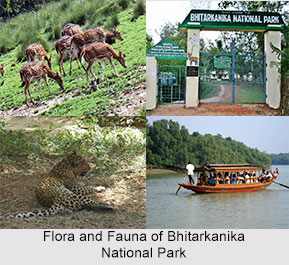 The 672 square kilometres of mangrove forest and wetland that comprised Bhitarkanika Mangrove Forests, provides home to well over 215 species of birds including winter migrants from central-Asia and Europe. The Giant salt water crocodiles and a variety of other wildlife inhabit this eco-system which is one of Asia`s most spectacular wildlife sanctuaries. The wetland of Bhitarkanika Mangrove Forests also hosts a large and diverse population of resident and migratory birds. Rhesus monkey, leopard cat, fishing cat, jungle cat, small Indian civet cat, toddy cat, common mongoose, jackal, striped hyena, Indian fox, wild pig, Indian porcupine, mole rat, long tailed tree mouse, spotted deer, sambar, common otter, smooth Indian otter are also found here.
The 672 square kilometres of mangrove forest and wetland that comprised Bhitarkanika Mangrove Forests, provides home to well over 215 species of birds including winter migrants from central-Asia and Europe. The Giant salt water crocodiles and a variety of other wildlife inhabit this eco-system which is one of Asia`s most spectacular wildlife sanctuaries. The wetland of Bhitarkanika Mangrove Forests also hosts a large and diverse population of resident and migratory birds. Rhesus monkey, leopard cat, fishing cat, jungle cat, small Indian civet cat, toddy cat, common mongoose, jackal, striped hyena, Indian fox, wild pig, Indian porcupine, mole rat, long tailed tree mouse, spotted deer, sambar, common otter, smooth Indian otter are also found here.
Notified Area of Bhitarkanika Mangrove Forests
The notified area of Bhitarkanika Mangrove Forests is known as Bhitarkanika National Park. It has an area of 145 square kilometres have been notified as Bhitarkanika National Park vide Notification No.19686/F and E dated 16.9.1998 of Forests & Environment Department, Government of Odisha. It has much significance with regard to ecological, geomorphologic and biological background which includes mangrove forests, rivers, creeks, estuaries, back water, accreted land and mud flats. Bhitarkanika National Park is the core area of Bhitarkanika Sanctuary.
Gahirmatha Marine Wildlife Sanctuary and Bhitarkanika Mangrove Forests
Gahirmatha Marine Wildlife Sanctuary, which bounds the Bhitarkanika Wildlife Sanctuary to the east, was created in September 1997, and encompasses Gahirmatha Beach and an adjacent portion of the Bay of Bengal. Bhitarkanika Mangrove Forests were designated a Ramsar Wetland of International Importance in 2002.
Plant Family in Bhitarkanika Mangrove Forests
The mangrove species in Bhitarkanika Mangrove Forests are home to 55 of India`s 58 known mangrove species. The mangroves harbour of Bhitarkanika Mangrove Forests is one of India`s largest populations of saltwater crocodiles, and Gahirmatha Beach, which separates the mangroves from the Bay of Bengal. Bhitarkanika Mangrove Forests are the world`s most important nesting beach for Olive Ridley Sea Turtles. Some wildlife experts are of the opinion that the largest saltwater crocodile ever was in Bhitarkanika Mangrove Forests, measuring an estimated 23 feet (7.0 m) which could be traced from the skull preserved by the Kanika Royal Family.
Crocodile History of Bhitarkanika Mangrove Forests
Crocodile was largely found in Bhitarkanika Mangrove Forests. The crocodile was shot near Dhamara in 1926, and later its skull was preserved by the then Kanika King of Kanika Palace. The crocodile experts estimate the animal to have been between 20 feet (6.1 m) and 23 feet (7.0 m) long, as the size of the skull was measured one ninth of the total length of the body. In 2006 the park was recognized by the Guinness Book of World Records for the largest white crocodile living in captivity also measuring 23 feet.
Related Articles
Types of Forest in India
Indian Tidal or Mangrove Forests
Mangroves in Odisha
Temples of Odisha
Odisha, Indian state
Nature Tourism in Odisha
Puri, Odisha
Districts of Odisha
